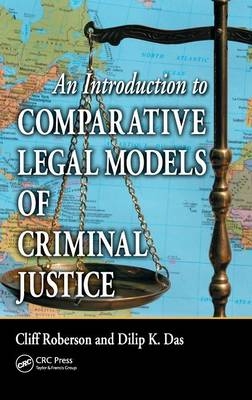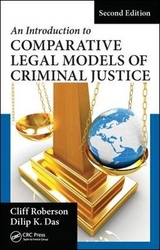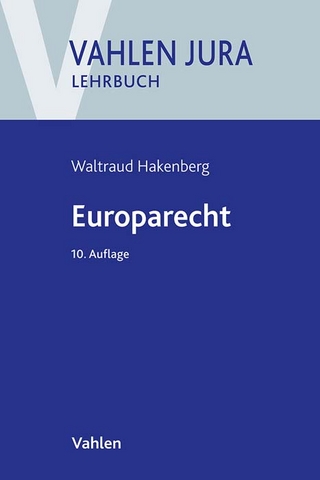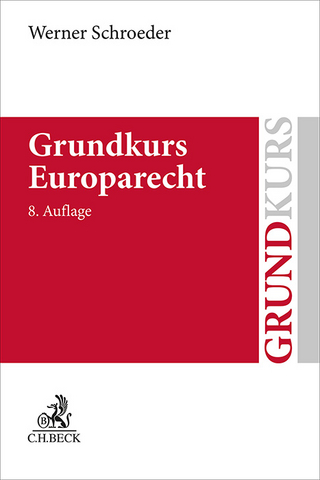
An Introduction to Comparative Legal Models of Criminal Justice
Crc Press Inc (Verlag)
978-1-4200-6592-3 (ISBN)
- Titel erscheint in neuer Auflage
- Artikel merken
While in Plato’s time there may have been some truth to his belief that there can only be "one single justice, and one single law," such is not the case today. Criminal justice systems vary widely across the world in their approaches to the problem of crime. Bringing together the collective wisdom of Cliff Roberson and Dilip K. Das, two world-renowned experts and university professors who have been involved in the criminal justice system for over thirty years, An Introduction to Comparative Legal Models of Criminal Justice presents the theme that a country’s legal model to a great extent determines the character of its police and corrections as well as its legal system. This book examines these different systems and is a useful reference guide for all criminal justice professionals.
Examines Various Approaches
The book begins with a brief overview of the five legal models. The continental (civil) system, characterized by an inquisitorial nature and practiced in most European countries, is discussed, followed by the common law model, which is known for its adversarial quality and is used in most English-speaking countries. The religion-based Islamic system and the rehabilitation-oriented Marxist system are also profiled. Those systems that are still emerging or are hybrid in nature are characterized as mixed. In some cases, the secretive nature of certain countries’ methods, especially those using extreme punishments, necessitated reliance on reports published by the U.S. State Department.
By examining how other societies deal with problems of justice, criminal justice professionals will gain insight as to which police and corrections methods are likely to be the most successful in their jurisdictions, and which will create more problems than they solve.
In 2009, a research study conducted by a group of professors from Sam Houston State University determined that Cliff Roberson was the leading criminal justice author in the United States based upon on his publications and their relevance to the profession. —Southwest Journal of Criminal Justice, Vol.6, issue 1, 2009
An Introduction to the Study of Comparative
Legal Models
Key Terms
Introduction
Words of Art
Legal Models
Jurisprudence
Natural Law
Positive Law Approach
Historical Approach
Law as an Instrument of Control
Function of a Court System
Brief Examination of the Legal Models
Roman Law
Revival of Roman Law
Commercial Law
Civil Law Model
Common Law Model
Islamic Model
Socialist Model
Mixed-Legal Model
Law Enforcement Systems
Punishments
Comparative Violence
Summary
Questions in Review
Common Law Model: The Courts
Key Terms
Introduction
Henry II
The Magna Carta
Sir Edward Coke
Sir William Blackstone
Common Law in the United States
U.S. Court Systems Today
Federal System
U.S. Court of Appeals
U.S. District Courts
U.S. Magistrates
Participants in a Criminal Case
Trial Judge
Defendant
Prosecuting Attorney
Law in Action: The Case of Wen Ho Lee
State Attorney General
Defense Counsel
The Right to Represent Oneself
Privileged Communication
Clerk of the Court
Bailiff
Court Reporter
Court Commissioners
English Court System Today
Court of Queen’s or King’s Bench
Supreme Court of Judicature
Magistrates’ Court
Crown Court
Royal Courts of Justice
Comparisons between the United States and the United
Kingdom
Practice of Law
Canadian Legal System
Court Structure
Provincial and Territorial Superior Courts
Provincial and Territorial Courts
The Judiciary
Right to Fair Trial versus Freedom of the Press
Scottish Legal System
Australian Legal System
Legal System
Classification of Crimes
Summary
Questions in Review
Policing and Corrections under the Common
Law Model
Key Terms
Policing in Common Law Countries
Deviance Control or Civil Order Control
Policing Models
Local Policing in the United States and England
Local Policing in the United States
Mission of Local Police Departments
Local Policing in England and Wales
Hiring Requirements for U.S. and English Police Officers
Salaries for English and U.S. Police Officers
Training of New Officers
Police Powers and Use of Discretion
Community Policing under the Common Law Model
Policing in Canada
Corrections in Common Law Countries
Sentencing
In the United States
In the United Kingdom and Wales
Sentencing in the United Kingdom
Confinement
Rates of Incarceration
Approaches to Confinement in the United States
English Purposes of Confinement
Prisons Ombudsman
Alternatives to Incarceration
Corporal Punishment
Fines
Probation
Probation in England
Probation in the United States
House Arrest
Death Penalty
Summary
Questions in Review
Civil Law Model: The Courts
Key Terms
Introduction
Early Tribal and Feudal Laws
Early Legislation
Influence of Roman Law
Canon Law
Commercial Law
Development of National Legal Systems 105
Napoleonic Code
German Legal Science
Codes in Civil and Common Law Models
Inquisitorial Prosecution
German Civil Law System
Rights of the Accused in a German Criminal Trial
Principle of Territoriality
Criminal Justice in France
Criminal Justice in Brazil
Summary
Questions in Review
Policing and Corrections under the Civil Law
Model
Key Terms
Introduction
Law Enforcement in France
Law Enforcement in Germany
Law Enforcement in Brazil
Corrections under the Civil Law Model
Pre-trial Diversion
Plea Bargaining
Confinement
Probation
Parole
Death Penalty
Fines
Summary
Questions in Review
The Islamic Law Model: The Courts
Key Terms
Introduction
Origins and Evolution
Sources
Fundamental Principles
Structure of Penal Law
Murder under Islamic Law
Evidence of Guilt
Confessions
Testimony of Eyewitnesses
Other Evidence
Doubt as to Guilt
Saudi Arabia
Criminal Cases
Pakistan
Iran
Summary
Questions in Review
Policing and Corrections under the Islamic Legal Model
Key Terms
Introduction
Saudi Policing
The Saudi Record on Human Rights
Torture and Other Cruel, Inhuman, or Degrading
Treatment or Punishment
Arbitrary Arrest, Detention, or Exile
Policing in Pakistan
Policing in Iran
Corrections
Amputation
Blood Money
Aid to Prisoners’ Families
Corrections in Iran
Corrections in Pakistan
Summary
Questions in Review
The Socialist Law Model: The Courts
Key Terms
Introduction
Legal System of Russia
People’s Republic of China
Crimes
Court System
Confessions
Law of Search and Seizure
Rights of an Accused
Court Procedures
Legal System of Cuba
Court Structure
Trial Procedure
Extradition from Cuba
Summary
Questions in Review
Policing and Corrections under the Socialist Law Model
Key Terms
Introduction
Public Trust and Community Policing
Policing in Russia
Policing in the People’s Republic of China
Use of Force by Police in China
Police Detention
Public Crime Statistics
Policing in Cuba
Corrections in Russia
Imprisonment in Russia
Corrections in China
Chinese Prisons
Early Release of Prisoners
Prison Conditions
Corrections in Cuba
Range of Punishments
Confinement in Cuba
Summary
Questions in Review
Mixed Law Models
Key Terms
Introduction
Bulgarian System of Law
Bulgarian Court System
Bulgarian Prosecutors
Crime Classification
Trial Procedure
Bulgarian Police System
Corrections in Bulgaria
Confinement in Bulgaria
Indian System of Law
Indian Legal History
Crime Classifications in India
Indian Court System
Policing in India
Criminal Process in India
Prosecutors
Corrections in India
Confinement in India
Sri Lankan System of Law
Criminal Justice System
Crime Classification
Sri Lanka’s Court System
Policing in Sri Lanka
Trial Procedures
Sentencing Process
Confinement in Sri Lanka
Summary
Questions in Review
International Courts
Key Terms
Introduction
International Criminal Court
The United States and the ICC
Establishment of the Court
President of the ICC
Judicial Divisions
Prosecutor
Registry
Other Offices
Jurisdiction and Admissibility
Procedure
Duties of States That Are Parties
Selected Court Cases
Trial Procedure of the ICC
International Court of Justice
Permanent Court of International Justice (PCIJ)
Establishment of the International Court of Justice (ICJ)
Resolution of Cases
Practice Directions
Jurisdiction of the ICJ
Contentious Cases
Advisory Proceedings
Court of Justice of the European Communities
Proceedings before the Court
Court of First Instance
Examples of Cases Brought before the Court of First Instance
Civil Service Tribune
Summary
Questions in Review
International Criminal Justice Agencies and
Associations
Key Terms
Introduction
Interpol
Structure
Core Functions
Trafficking in Human Beings
Corruption
Child Sexual Exploitation
Public Safety and Terrorism
Drugs
Criminal Organizations
Financial and High-tech Crimes
Fugitive Investigative Services
Interpol’s Other Areas of Crime
National Central Reference Points Network
International Cyber-crime Conference
Europol
The Europol Computer System (TECS)
International Association of Chiefs of Police
International Police Association
United Nations Crime Prevention and Criminal Justice
Network
U.N. Commission on Crime Prevention and Criminal Justice
International Centre for Criminal Law Reform and
Criminal Justice Policy
Criminal Justice Reform Unit
Office for Drug Control and Crime Prevention
Institutes of the U.N. Crime Prevention and Criminal
Justice Programme Network
Commission on Narcotic Drugs
U.N. Terrorism Prevention Branch
International Narcotics Control Board
Transnational Organized Crime
Trafficking in Humans
United Nations Protocol to Prevent, Suppress and Punish
Trafficking in Persons, Especially Women and Children
Trafficking in Firearms
International Police Executive Symposium
International Policy Institute for Counter-Terrorism
Organization of American States
Child Wise
Summary
Questions in Review
APPENDIX A: ICC Arrest Warrant for Thomas Lubanga Dyilo
APPENDIX B: First Appearance before the International Criminal Court in Case of Prosecutor v. Thomas Lubanga Dyilo
APPENDIX C: Excerpts from the United Nations
Global Counter-Terrorism Strategy Resolution Sixtieth Session: Resolution Adopted by the General Assembly
References
Index
| Erscheint lt. Verlag | 11.6.2008 |
|---|---|
| Zusatzinfo | 21 Halftones, black and white; 1 Tables, black and white; 24 Illustrations, black and white |
| Verlagsort | Bosa Roca |
| Sprache | englisch |
| Maße | 156 x 234 mm |
| Gewicht | 635 g |
| Themenwelt | Recht / Steuern ► EU / Internationales Recht |
| Recht / Steuern ► Strafrecht | |
| Sozialwissenschaften ► Politik / Verwaltung | |
| ISBN-10 | 1-4200-6592-0 / 1420065920 |
| ISBN-13 | 978-1-4200-6592-3 / 9781420065923 |
| Zustand | Neuware |
| Haben Sie eine Frage zum Produkt? |
aus dem Bereich



